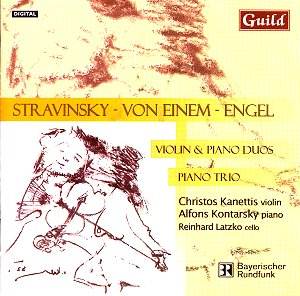Stravinsky’s ballet, Le baiser de la fée,
based on Hans Christian Andersen, was premièred in Paris
in 1928. It was Stravinsky’s tribute to Tchaikovsky. Four years
later, in 1932, violinist Samuel Dushkin collaborated with Stravinsky
to produce this arrangement for violin and piano. The Divertimento
is not an easy piece, and it is a tribute to Salonican violinist
Christos Kanettis and his accompanist, Alfons Kontarsky (half
of the famous piano duo), that it comes up fresh as a daisy in
this account. Kanettis is agile and in tune in the opening ‘Sinfonia’,
displaying a sonorous low register. There is a very Stravinskian
dryness to the ‘Danses suisses’, and the feather-light accompaniment
to the Pas de deux’s Adagio is most welcome. The Coda is almost
slapstick. This is a very promising start to this recital disc.
Austrian composer, Paul Engel studied with Wilhelm
Killmayer. His music has previously been featured on Guild. His
Te deum appears on GMCD7245. In Sonogramm I, he
draws inspiration from the chamber works of great Viennese masters
of the 18th century, but has a strong personality of
his own. Starting from a distinctly Beethoven-flavoured beginning
of resolute chords, a gradual tempo acceleration works in tandem
with more and more progressive language as the piece blossoms
into a statement in its own right in a clear twentieth-century
idiom. Nevertheless, it is always approachable. Both players rise
to the many challenges in the most musical ways.
Engel’s Piano Trio No. 5, titled, ‘Calliope’s
descent from Olympus’, is even more impressive. As the composer
states, ‘In view of the terribly hectic pace of modern life it
seems to me timely to look again at ancient mythology …’. Certainly
the glassy stasis of the opening evokes an other-wordly atmosphere.
The piece wears its 25 minute duration well, chiefly because of
Engel’s fluent textural imagination (in particular, there is a
compelling motoric section ). It has to be said that the composer’s
own programme, centring on Calliope, seems a trifle superfluous,
however. All three players (cellist Reinhard Latzko joining the
duo) give their all.
The two Engel pieces enclose a performance of
Gottfried von Einem’s three-movement Violin Sonata, Op. 11 of
1949. Einem was a pupil of Boris Blacher, and four of his operas
are to libretti by his teacher. The Violin Sonata abounds with
jazzy rhythms along with a more astringent streak analagous to
some Stravinsky. It is a brief piece, but within its brevity lies
much concentration, particularly in the Larghetto middle movement..
The programming of this disc is remarkably thought-provoking
and intelligent. Marc Rochester’s notes are unfailingly informative,
and the Bavarian Radio recording is perfectly acceptable. Warmly
recommended.
Colin Clarke
